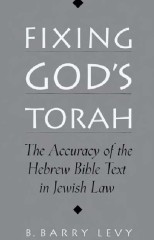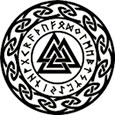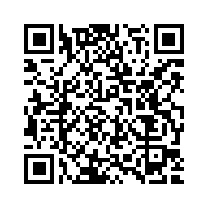
Author : Levy B. Barry
Title : Fixing God's Torah The Accuracy of the Hebrew Bible Text in Jewish Law
Year : 2001
Link download : Levy_B_Barry_-_Fixing_God_s_Torah.zip
Contemporary interest in the state of the Torah's textual precision lags far behind the more widespread and betterknown concerns about its historical accuracy. Yet the textual integrity of every biblical book should be extremely important to those interested in either the Hebrew Bible or classical Jewish thought. Indeed, it is one of the many Bible-related issues discussed in numerous tractates of the Talmud, books of midrashic Bible interpretation, mystical writings of the medieval and postmedieval kabbalists, Bible commentaries, works of Hebrew linguistics, guidebooks for Torah scribes, and exacting codes and essays that are integral parts of the halakhic literature (the formal and binding system of Jewish religious law). These authoritative works reflect and in some cases control the consonantal text of the Torah and of other hand-copied Bible scrolls, which, for our purposes, must be differentiated from the similar but more detailed copies of the masoretic text (including most printed Bibles) that also contain the vocalization and cantillation signs and often one or more sets of detailed textual notes, known collectively as the Masorah. Comparison of these two complementary corpora—scrolls on the one hand and texts containing all or part of the Masorah on the other—offers no evidence of the recensional variations that have emerged from studies of some prerabbinic Bible manuscripts, but neither does it produce one completely uniform text. In fact, these corpora and the rabbinic discussions of them do provide important data that augment the story of the Bible text's evolution from antiquity to the present. Most text critics, whose attention is focused on the ancient prerabbinic evidence, devote little attention to these rabbinic works. Indeed, one often hears them claim that no significant textual variants are found or discussed in rabbinic literature and that one should not even expect to find the problem addressed by writers who doubted the very possibility of variations in a divinely revealed and perfectly transmitted text. Concomitantly, some students of rabbinic literature have concluded that the rabbis' many precise statements about textual details assume letter-perfect accuracy as well as unanimous agreement of all testimonies to all related textual matters, whatever their apparent significance. In certain religious circles, the existence of disagreements agreements over textual details, particularly spelling, is actually deemed impossible, and consideration of the problem is judged to be inappropriate or foolish, at best, if not downright heretical. Premodern Jewish discussions of the Bible's accuracy were based almost exclusively on the scriptural texts transmitted by Jews and the many related rabbinic teachings, some of which suggest that the rabbis' Bibles contained wordings or spellings that differed slightly from those now in use. The evidence from the Samaritan Pentateuch and the Septuagint, for example, was either unavailable or largely disregarded, because rabbinic leaders did not take seriously the possibility that someone other than their forebears could have preserved the correct text. But significant nonmasoretic variants do appear in rabbinic literature; the rabbis did recognize variants in their own textual traditions; and they did discuss the Septuagint and the Samaritan Pentateuch on occasion. In fact, rabbinic material, early and late, is far from irrelevant to reconstructing the history of the Bible text. But even had the rabbis been willing to consider the possibility that these other texts were correct (in isolated cases, if not globally), popular and mystical Jewish sentiments strongly opposed this stance. In addition, and in some contexts even more significantly, the pressing realities of anti-Jewish polemics, motivated in part by a strong desire to discredit both the Hebrew Bible text and the Jews' faithful transmission and interpretation of it, militated against making any such concessions. Naturally, documents like the Dead Sea Scrolls, many of which date from pre-Christian times but became known only in the recent past, had no impact on the development of this literature; to the best of my knowledge, they still do not. As additional nonreceptus texts continued to become available, scholars of the past few centuries rapidly moved beyond the limitations imposed by the selective use of only Jewish (or, in some cases, Jewish and early Christian) source material and, in the process, came to ignore the discussions of their rabbinic contemporaries, who were thought to be uninterested in the issue, if not entirely hostile to it. Because the minor differences emerging from these rabbinic observations are less spectacular than the so called recensional variations recovered from some earlier witnesses, rarely if ever are they discussed in the scholarly literature about the evolution of the text. Because they trouble certain religious interests, popular Jewish writings about the Bible also avoid them. Indeed, the virtually universal decision of contemporary rabbinic teachers and writers not to explore this subject on a popular level, and, even more so, their failure to address it in many contexts of advanced learning, have created an intellectual vacuum that allows all sorts of silly notions to catch the public's fancy, the latest and most widespread manifestation of which is the “decoding” craze. Basing themselves on the erroneous assumption that the text is letter-perfect, dozens of latter-day aficionados, including some respected mathematicians, are decoding the Torah and other biblical books. To do this, they position the text in grids of varying sizes, thereby juxtaposing letters originally found at recurring, often very extensive intervals. This positioning creates new combinations of letters that, when read frontwards, backwards, or diagonally, can be interpreted as words. Counting every nth letter from various arbitrary starting points seemingly reveals allusions to Napoleon, AIDS, Israeli and American politics, the Holocaust, and other medieval, early modern, and contemporary figures and events. In like manner, Christians are decoding Hebrew Bible texts and finding references to Jesus and to christological themes. They are also decoding the New Testament, as are Muslims the Qur'an. Decoding generates limitless letter combinations, some of which resemble words, but attributing meaning to them requires accepting many dubious assumptions. First, one must be convinced that such decodings cannot be mere random coincidences. Also, one must agree that, when the Torah text was formed, detailed knowledge of the future was possible, available, and actually encoded in it—that is, that some higher intelligence intended what is perceived as encoded information; that transmission of the Torah text has been so accurate that these messages are still intact; and that the decoded combinations of letters are valid representations of the people, dates, and events with which they are associated. Despite the simplicity and clarity attributed to the decoding process, making sense of the alleged messages often requires no small amount of ingenuity and subjectivity. God is often assumed to be the encoder (indeed, the results of the decoding effort are often used to suggest or to confirm a belief in a text's divine authorship). This notion reinforces the Torah's sanctity and authority and may sound quite pious to some readers, but a philosophy predicated on such extensive predestination is far from a universally accepted idea among traditional Jewish thinkers. Even Jewish religious law does not support the decoders' claims, because it cannot sustain belief in a letter-perfect text; indeed halakhic authorities often claim just the opposite, which is demonstrated conclusively by many of the texts discussed in this book. Despite the halakhic preference that all Torah scrolls be identical, a universal text containing 304, 805 letters—one preferred form—exists only among preselected exemplars. All copies are not identical; they are only very nearly so. In fact, the past 2,000 years have witnessed numerous rabbinic debates about hundreds of spelling variations in the Torah and thousands throughout the Bible. The discovery of allegedly encoded meanings in mechanically generated letter combinations taken from the Bible ignores all this and, instead, shares much with ancient and medieval textual manipulations that originated as pious play and with now discredited notions regarding the movements of the stars, the shapes of human skulls, and the palm lines on one's hands. Because of being associated with some scientifically accurate information, such thinking has often been confused with science, but eventually serious study helped to debunk it. Despite the popular, pious-sounding assumption that the Torah text is letter-perfect, frequent and extensive discussions by highly respected rabbinic leaders demonstrate that they, in some measure similar to modern scholars, were concerned about its true textual state; some of them even tried to clarify known textual doubts and to eliminate many troublesome inconsistencies. Basing their discussions on a series of passages from ancient and early medieval rabbinic documents that explored the significance of pentateuchal variations—usually in contexts about writing, reading, or correcting Torah scrolls—many famous halakhic authorities entertained serious doubts about the letterperfect accuracy of the Torah and, by extension, the rest of the Bible. In all likelihood, rabbinic literature would contain even more such discussions, but many have been avoided out of frustration at the lack of a definitive solution. Often this silence has led to misunderstandings and mistakes, but it should not be interpreted as simple acceptance of otherwise indefensible positions on textual uniformity. My present efforts attempt to clarify the nature and extent of some of these doubts and how they were dealt with, particularly between the thirteenth and sixteenth centuries. In addition to providing extensive evidence of the subject's universal importance, they demonstrate that the rabbinic writers of the past were far more aware of textual inconsistencies in the Bible than is usually acknowledged by today's rabbinic writers, that they appreciated the legal and interpretative implications of this evidence, and that their overall reactions were, in many cases, far from what they are often imagined to be. ...

Tourney Phillip - What I saw that day
Authors : Tourney Phillip F. - Glenn Mark Title : What I saw that day Year : 2011 Link download :...














